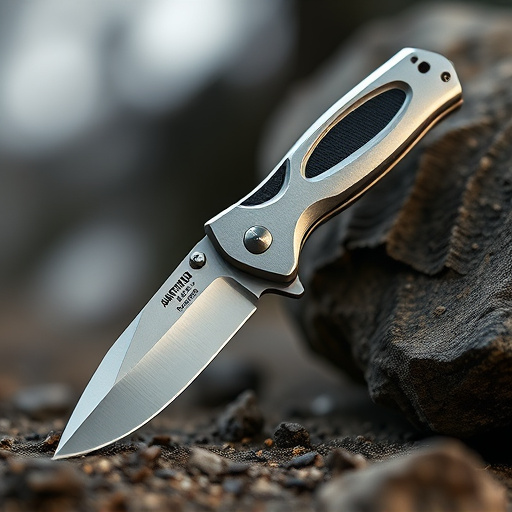OTF (Out-the-Front) automatic knives are compact, versatile folding tools with rapid blade deployment via a simple thumb flick. Their innovative design combines precision engineering and seamless transition between open and closed positions, offering tactical advantages for outdoor use and self-defense. With high-quality materials and durable construction, OTF autos cater to various user needs, from everyday carry to advanced tactical models. While convenient, these knives require careful consideration of safety and local regulations, with proper maintenance for reliable performance.
“Discover the world of OTF (Out-the-Front) automatic knives—a versatile tool that seamlessly combines convenience and power. This comprehensive guide unravels the mechanics, designs, and applications of these innovative blades. From their intricate folding mechanisms to various types catering to different needs, we explore how OTF knives offer unmatched versatility. Weighing the benefits, understanding safety norms, and navigating regulations, this article is your go-to resource for everything related to OTF automatic knives.”
Understanding OTF Automatic Knives: A Comprehensive Overview
OTF (Out-the-Front) automatic knives are a unique and versatile category of folding knives designed for swift deployment and easy carry. These innovative tools feature a sliding mechanism that allows the blade to extend rapidly from the handle, providing instant access when needed. Unlike traditional folding knives, OTF autos offer a seamless transition between open and closed positions, making them incredibly convenient for everyday carry enthusiasts.
The key advantage lies in their compact size and discreet appearance when closed. This design enables users to carry a powerful cutting tool without drawing unnecessary attention. With a simple flick of the thumb, the blade can be quickly extended, providing a tactical edge for various tasks, from outdoor adventures to self-defense situations. OTF automatic knives have gained popularity among those seeking a reliable and efficient cutting solution that combines functionality with portability.
How Do They Work? The Mechanics Behind the Blade
OTF (Out-the-Front) automatic knives are a fascinating blend of precision engineering and innovative design. Their functionality hinges on a complex yet elegant mechanism that allows for swift and precise blade deployment. When the trigger or switch is activated, a series of intricate components work in harmony to extend the blade rapidly from its hidden compartment. This process involves a tactical lever, a spring-loaded system, and a robust locking mechanism, ensuring both speed and security.
The blade itself is typically designed with a high-quality stainless steel construction, offering exceptional durability and sharpness. Its unique folding mechanism enables it to lock into place when extended, providing a firm and secure grip for various cutting tasks. This seamless integration of components results in the swift and reliable operation of OTF automatic knives, making them popular choices among enthusiasts, collectors, and those seeking efficient self-defense solutions.
Types and Designs: From Folding to Fixed Blades
Automatic knives, also known as OTF (Out-the-Front) knives, come in a wide variety of types and designs to suit different needs and preferences. One of the most common types is the folding knife, which features a blade that folds into the handle for easy carry. These knives are versatile and popular among everyday carriers due to their compact size and quick deployment mechanism. On the other end of the spectrum, fixed-blade automatic knives offer a more durable and robust option, ideal for outdoor adventures or tactical applications. With a blade permanently attached to the handle, these knives provide increased stability and strength but come with a larger profile.
Designers have also explored unique concepts, such as tactical automatic knives with various lock mechanisms, serrated edges, and customizable features. Some models incorporate advanced materials like titanium or carbon fiber for enhanced durability and lightweight construction. Additionally, aesthetics play a significant role in the design of these knives, with custom engravings, intricate patterns, and stylish handles appealing to collectors and enthusiasts alike. This diversity in types and designs ensures that there’s an automatic knife tailored to almost every purpose and personal taste.
Benefits and Applications: When is an Automatic Knife Useful?
An OTF (Out-the-Front) automatic knife offers a multitude of benefits for various applications, making it a handy tool for many situations. One of its primary advantages is speed and convenience; with a simple flick of the thumb, the blade swiftly extends, allowing users to quickly access a cutting edge without the need for manual opening or locking mechanisms. This feature is particularly useful in survival scenarios, outdoor adventures, or self-defense situations where time is of the essence.
These knives are versatile and can be employed in numerous contexts. For instance, they are excellent for hunting or camping trips, providing a reliable cutting tool for preparing game or navigating through rugged terrain. In everyday carry scenarios, an automatic knife ensures users are prepared for unexpected tasks, from opening packaging to performing simple repairs. Moreover, their discreet design and compact size make them ideal for personal safety, offering a concealed yet powerful defense option.
Safety Considerations and Regulations: Knowing Your Limits
When considering an OTF (Out-the-Front) automatic knife, safety should always be the top priority. These advanced blades can provide immense convenience and power, but they also come with unique risks. Understanding your local regulations is crucial; many regions have strict laws regarding automatic knives to ensure public safety. Owning an OTF knife may be restricted or outright prohibited in certain areas, so it’s essential to know your rights and responsibilities.
Additionally, familiarizing yourself with the knife’s mechanics and limitations is vital. Automatic knives are designed for specific tasks and may not suit every situation. Users should be aware of the blade’s extension and retraction mechanisms, lock systems, and safe disassembly procedures. Regular maintenance and inspections can help prevent accidents and ensure the knife remains a reliable tool within its intended parameters.
